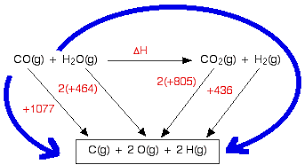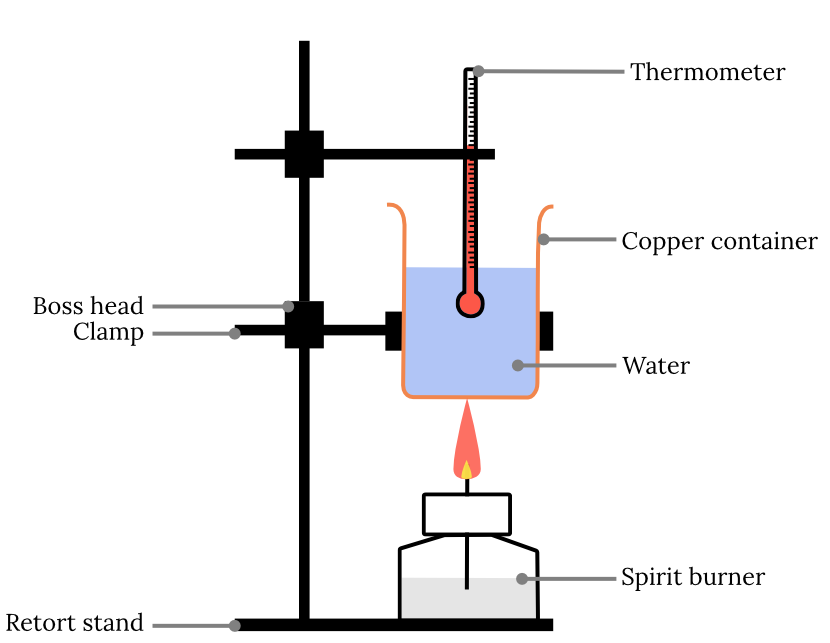enthalpy changes, measurement, bond enthalpies
1/23
There's no tags or description
Looks like no tags are added yet.
Name | Mastery | Learn | Test | Matching | Spaced |
|---|
No study sessions yet.
24 Terms
Enthalpy change
ΔH=H(products)-H(reactants); can be +ve/-ve
Exothermic
More (heat) energy released forming bonds than energy absorbed breaking bonds
ΔH-ve
Products have less energy than reactants, and therefore are more thermodynamically stable
Enthalpy profile diagram

Hess cycle for combustion
CO2 and H2O being combustion products
arrows point down at them
must add balancing numbers
-even if you need to find out Enthalpy change of formation, if you are given combustion data you have to draw a combustion cycle
Activation energy (Ea)
Minimum energy required for a reaction to take place by breaking chemical bonds in reactants
Standard state
Physical state of a substance under standard conditions
Enthalpy change of formation
Enthalpy change when 1 mole of a compound is formed from its elements in their STANDARD STATES under standard conditions
Enthalpy change of combustion
the enthalpy change when 1 mole of a substance is completely burned in oxygen under standard conditions.
Enthalpy change of neutralisation
Formation of one mol of water from neutralisation under standard conditions
(same for all neutralisation reactions H+ + OH- → H2O)
q=mcΔT
Equation for heat energy (q) = mass (m) × specific heat capacity (c) × temperature change (ΔT)
E is in Joules
m is in grams (of water)
Reasons experimental change in enthalpy is not accurate
-heat loss to surroundings (calculated value is lower)
-incomplete combustion of fuel (lower)
-non-standard conditions
Average bond enthalpy
-Enthalyp change when one mole of covalent bonds in GASEOUS molecules is broken
-always endothermic
-calculated by energy required to break bonds - energy released when new bonds form
-in Hess cycle, arrows point DOWN to atoms

Enthalpy change of reaction
The enthalpy change when the reactants convert to products with the number of moles shown in the equation under standard conditions
ΔrH=Σ(bond enthalpies reactants)-Σ(bond enthalpies products) (need to be gaseous to be standard)
Hess' law
-total enthalpy change accompanying a chemical change is independent of the route by which a reaction takes place
-Allows enthalpy changes to be determined indirectly
-if a reaction can take place by 2 routes & starting/finishing conditions are the same, the total enthalpy changes are the same
Standard conditions
-an agreed set of conditions which allow fair comparisons between different sets of experimental data
-298K (25C) for temperature
-100kPa for pressure
-sometimes 1 moldm^-3
Calorimetry
a method used to determine amount of heat energy given off by a chemical reaction
energy release is supposed to heat up a measured amount of water
1cm^3 = 1g
-the spirit burner/fuel's change in mass is weighed
-insulation needed (e.g. polystyrene cup)

Questions on Hess cycle involving bond enthalpies
-GASEOUS atoms must be at the bottom
What's the difference between a method and a measurement error?
-method is a systematic error
-measurement is a random error, usually smaller
What is an absolute error/uncertainty?
+/- half the minimum measurement
How do you work out percentage error?
absolute error/measured value x 100
if you take 2 readings it's absolute error x2
-e.g. temp. change from, 22 to 42 so measured value is 20
How can you reduce percentage error?
-increase resolution to decrease absolute error or scale up reactants to increase measured value
How would you work out the enthalpy change of combustion of ethanol?
-energy transferred to WATER/ moles of ETHANOL burned
why is enthalpy change of vapourisation of bromine endothermic
energy required to break induced dipole forces